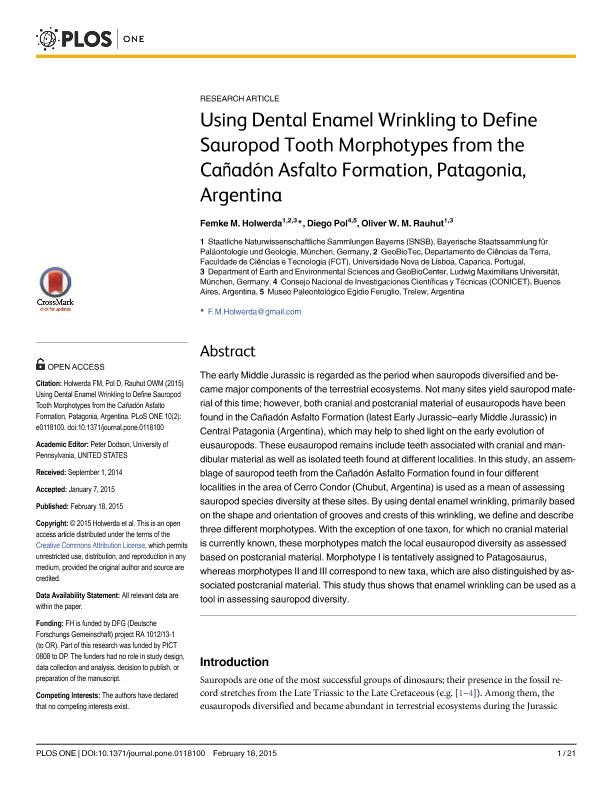Artículo
Using dental enamel wrinkling to define sauropod tooth morphotypes from the Cañadón Asfalto Formation, Patagonia, Argentina
Fecha de publicación:
02/2015
Editorial:
Public Library of Science
Revista:
Plos One
ISSN:
1932-6203
Idioma:
Inglés
Tipo de recurso:
Artículo publicado
Clasificación temática:
Resumen
The early Middle Jurassic is regarded as the period when sauropods diversified and became major components of the terrestrial ecosystems. Not many sites yield sauropod material of this time; however, both cranial and postcranial material of eusauropods have been found in the Cañadón Asfalto Formation (latest Early Jurassic–early Middle Jurassic) in Central Patagonia (Argentina), which may help to shed light on the early evolution of eusauropods. These eusauropod remains include teeth associated with cranial and mandibular material as well as isolated teeth found at different localities. In this study, an assemblage of sauropod teeth from the Cañadón Asfalto Formation found in four different localities in the area of Cerro Condor (Chubut, Argentina) is used as a mean of assessing sauropod species diversity at these sites. By using dental enamel wrinkling, primarily based on the shape and orientation of grooves and crests of this wrinkling, we define and describe three different morphotypes. With the exception of one taxon, for which no cranial material is currently known, these morphotypes match the local eusauropod diversity as assessed based on postcranial material. Morphotype I is tentatively assigned to Patagosaurus, whereas morphotypes II and III correspond to new taxa, which are also distinguished by associated postcranial material. This study thus shows that enamel wrinkling can be used as a tool in assessing sauropod diversity.
Palabras clave:
Sauropoda
,
Jurassic
,
Enamel
,
Diversity
Archivos asociados
Licencia
Identificadores
Colecciones
Articulos(SEDE CENTRAL)
Articulos de SEDE CENTRAL
Articulos de SEDE CENTRAL
Citación
Holwerda, Femke M.; Pol, Diego; Rauhut, Oliver Walter Mischa; Using dental enamel wrinkling to define sauropod tooth morphotypes from the Cañadón Asfalto Formation, Patagonia, Argentina; Public Library of Science; Plos One; 10; 2; 2-2015; 1-21; e0118100
Compartir
Altmétricas




